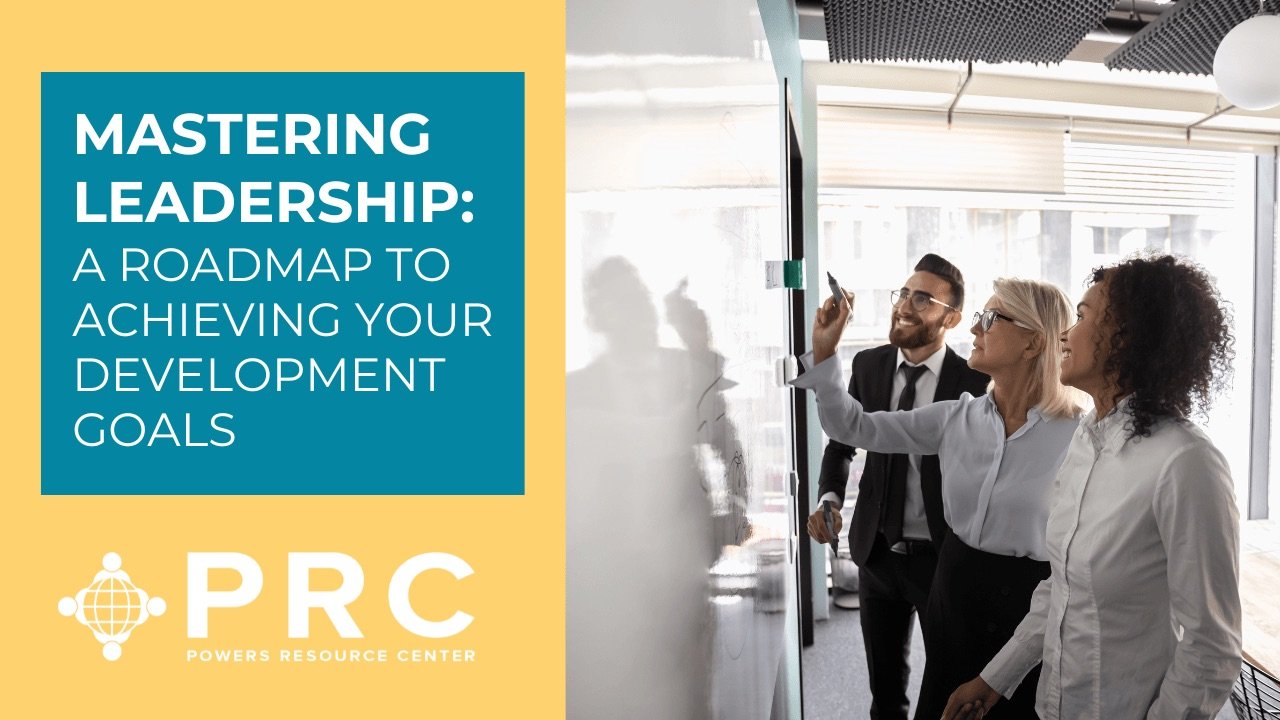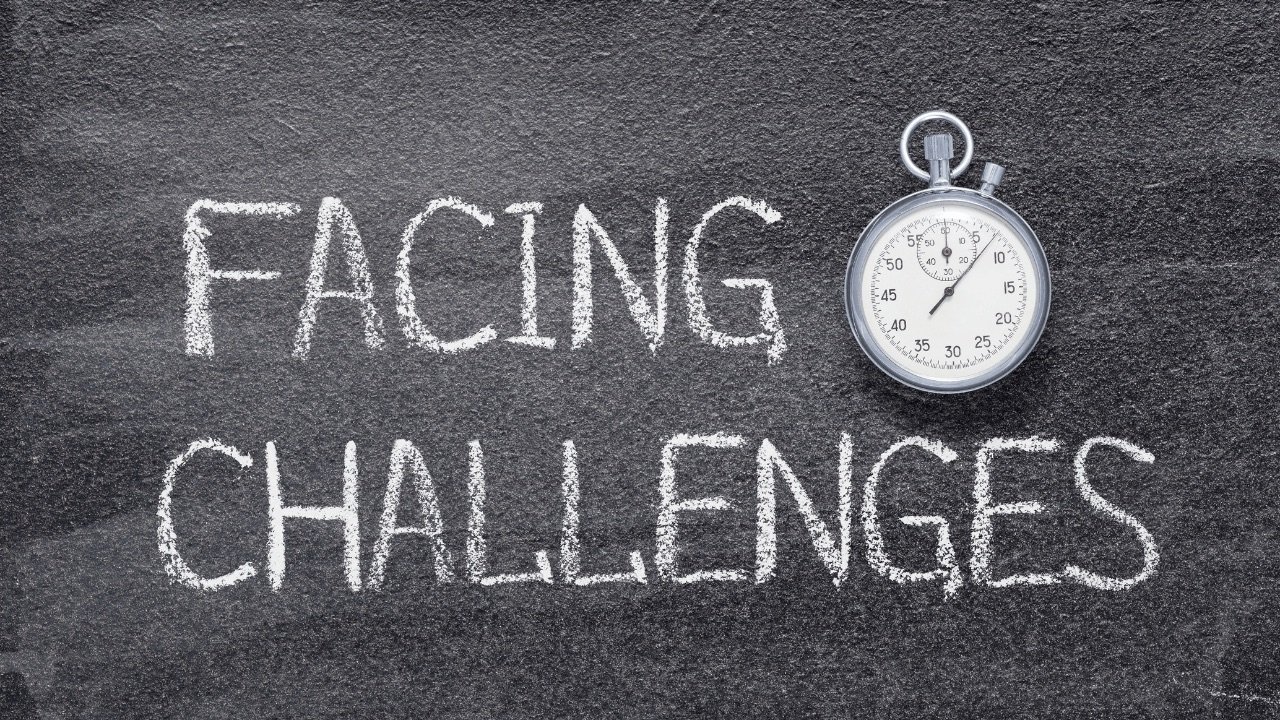Mastering Leadership: A Roadmap to Achieving Your Leadership Development Goals
Effective leadership today is not about being in charge. It’s about taking care of those in your charge. And developing your leadership skills so you can guide, lead and care for those in your world is the ultimate investment in yourself AND your people, as well as fostering a positive work environment for all.
So, where do we begin?
Leadership development is really about the deliberate and structured process of enhancing your abilities, skills, and qualities to become an effective leader. It’s a continuous journey of lifelong learning aimed at improving leadership traits, behaviors, and competencies to lead oneself, teams, or entire organizations more effectively.
Ultimately, leadership development is not just about obtaining a title or position—it’s about becoming the best version of yourself and empowering others to reach their full potential. It’s a journey that not only benefits your professional life but can also have a profound impact on your personal growth and the success of the teams and organizations you lead.
Leadership development is crucial for several reasons. Let’s dive in…
Leaders set the course for their teams and organizations. They develop a vision, outline goals, and guide their teams toward achieving them. Without effective leadership, there can be a lack of direction and focus, leading to confusion and inefficiency and, let’s face it, downright disgruntled people. That’s why developing leadership skills, even with high potential, ensures a continuous pipeline of capable leaders.
By investing in the growth and development of potential leaders, organizations can ensure sustainability and succession planning, as well as an aligned, cohesive, and productive workforce.
Effective leadership matters AND makes a difference…
We’ve all seen it and hopefully experienced it, too…good leaders inspire and motivate their teams. When employees feel supported, valued, and led by competent individuals, they’re more engaged and connected, leading to higher productivity, creativity, and overall job satisfaction. And strong leadership encourages a culture of innovation and experimentation.
Leaders who foster an environment of trust and openness allow for new ideas to flourish, leading to adaptability in ever-evolving markets, not to mention stronger wellbeing at work for everyone involved.
And effective leaders make informed and timely decisions. Developing leadership skills and setting leadership goals involves honing the ability to acknowledge strengths and weaknesses, analyze situations, consider various perspectives, and make sound judgments, which is critical for organizational success and a positive work environment. Leaders greatly influence the culture of an organization.
What is emotional intelligence and why does this matter in leadership training?
Emotional intelligence (EQ) is the ability to understand and regulate your own emotions and to recognize and influence the emotions of others. In leadership, it’s a crucial skill because it helps leaders navigate social complexities, build relationships, and make informed decisions based on empathy and understanding.
Leaders with high EQ can effectively communicate, resolve conflicts, inspire and motivate their teams, and foster a positive work environment. Plus, team members often regulate their own emotions based on the tone and the vibe their leaders set.
Training on EQ often covers self-awareness, self-regulation, social awareness, and relationship management—the four core components of EQ. It helps leaders develop empathy, improve communication, handle stress, and make better decisions, ultimately enhancing their leadership capabilities and the overall performance of their teams and organizations. And who doesn’t want more of THAT?
Great leaders are DEVELOPED, not born.
A focus on leadership development ensures that leaders align with the organization’s values, thereby reinforcing a positive and productive workplace culture…whether the team is working from home, the office or in a hybrid environment.
We know now more than ever that in a rapidly changing world, adaptability to change is crucial. Strong leadership enables smooth transitions during periods of change, growth and challenges, reducing resistance and ensuring continuity in operations.
Plus, leaders who invest in their own development can better support their teams, understanding team dynamics, effectively delegating tasks, and providing guidance during change…resulting in cohesive and high-performing teams.
Developed leaders with strong emotional intelligence change company culture…for the better.
Ultimately, we also know that effective leadership impacts the bottom line. Leaders who continuously develop their skills and focus on leadership goals contribute to better decision-making, innovation, employee retention, and overall organizational success.
In essence, leadership development is not just about individual growth; it’s about shaping the future of organizations and their ability to navigate challenges, inspire teams, and achieve their development goals.
So, how do we set clear goals for leadership growth?
First, we need to understand what qualities define great leaders…
Leadership qualities encompass a diverse set of characteristics and behaviors that effective leaders possess. These qualities are often defined by a combination of innate traits and learned skills.
Some key leadership qualities include:
Vision: Leaders have a clear vision of where they want to go and can articulate this vision to inspire and motivate others.
Integrity: Ethical behavior, honesty, and consistency in actions build trust and credibility, crucial for effective leadership.
Resilience: Leaders must navigate challenges and setbacks. Resilience allows them to persevere, learn from failures, and adapt in adverse situations.
Communication: Effective communication skills are fundamental. Great leaders listen actively, express ideas clearly, and foster open dialogue within teams.
Empathy: Understanding and empathizing with others’ perspectives and our shared humanity fosters strong relationships, leading to better collaboration and team cohesion.
Decisiveness: Leaders need to make timely and well-informed decisions. Decisiveness, coupled with sound judgment, is essential in leadership roles.
Innovation and Creativity: Encouraging innovation and creative thinking drives progress. Leaders who foster a culture of innovation can propel their teams forward.
Adaptability: In a rapidly changing environment, adaptability is crucial. Leaders who can pivot, learn, and adjust quickly are better equipped to lead effectively.
Influence and Inspiration: Inspiring and influencing others to work towards a common goal is a hallmark of effective leadership.
Delegation and Empowerment: Leaders delegate tasks and empower their teams, allowing individuals to grow, take ownership, and contribute meaningfully.
Strategic Thinking: Leaders need to see the bigger picture and develop strategies to achieve long-term goals while managing day-to-day operations.
Accountability: Taking responsibility for actions and outcomes, both individual and collective, is essential for a leader’s credibility.
These leadership goals are not exhaustive, and different situations may call for a blend of various leadership traits.
And, of course, effective leadership is not solely about possessing these traits but also about continually developing and adapting them to effectively lead teams and achieve organizational goals.
In other words, being in partnership with yourself as an evolving leader, adopting a growth mindset, understanding your strengths and weaknesses, and being willing to learn and make mistakes are the building blocks of successful leadership and a positive work environment.
Now, let’s assess your current leadership skills….
Assessing your current leadership skills involves a combination of self-reflection, seeking feedback from others, and utilizing various assessment tools to identify and understand your strengths and weaknesses.
Here’s our step-by-step guide:
Do a Self-Reflection:
Review your experiences: Reflect on past leadership roles, projects, and challenges through the lens of self-awareness. Consider what worked well and where you faced difficulties.
Identify strengths and weaknesses: Assess your perceived strengths as a leader (e.g., communication, decision-making, time management) and areas you believe need improvement (e.g., delegation, conflict resolution).
Consider leadership style: Determine your predominant leadership style—autocratic, democratic, transformational, etc. Understand how this style impacts your interactions and decision-making.
Collect Feedback from Others:
Seek input and constructive criticism from colleagues, supervisors, or team members: Ask for honest feedback about your leadership style, communication, problem-solving, and team management.
Use 360-degree feedback tools: These tools gather feedback and constructive criticism from multiple sources to provide a comprehensive view of your strengths, areas for development and ideas for leadership goals.
Utilize Assessment Tools and Resources:
Leadership assessment surveys: Use reputable leadership assessment tools or surveys available online. These tools often provide questionnaires to evaluate various leadership competencies.
Competency frameworks: Explore leadership competency frameworks provided by professional organizations or leadership development programs. Assess where you stand against these established competencies.
Compare with Ideal Leadership Skills:
Review leadership models: Familiarize yourself with established leadership models (e.g., situational leadership, servant leadership) and assess how your skills align with these models.
Compare with industry standards: Research industry-specific leadership benchmarks or standards to understand where your skills stand within your field.
Perform a Gap Analysis and Create an Action Plan:
Analyze the gaps: Compare your self-assessment, feedback, and assessment results to identify common areas for improvement.
Develop an action plan: Prioritize areas needing improvement and set SMART (Specific, Measurable, Achievable, Relevant, Time-bound) goals. Plan specific actions, such as training, mentoring, or skill-building activities, to enhance your leadership skills.
Continually Evaluate:
Regularly review progress: Monitor your development regularly and adjust your action plan as needed.
Seek ongoing feedback: Continue seeking feedback from peers, mentors, and team members to track progress and make necessary adjustments.
Assessing your leadership skills and nailing down your leadership development goals is an ongoing process. Regular self-assessment, feedback collection, and intentional skill development are crucial for continuous improvement as a leader.
It’s all part of the job!
From there, leaders can work on identifying areas for improvement.
From there, leaders can work on identifying areas for improvement.
Identifying areas for improvement in your leadership skills involves a blend of the list above and always includes self-reflection, feedback from others, and objective assessment to hone in on strengths and weaknesses.
Here’s a guide to help you pinpoint areas that might need enhancement:
Identify Patterns and Challenges:
Look for recurring challenges: Identify patterns in areas where you frequently face obstacles or difficulties. It might relate to communication, decision-making, conflict resolution, self-awareness, time management, etc.
Assess team dynamics: Consider team performance and dynamics. Are there consistent issues within your team that could be linked to your leadership style or skills? Do you see patterns that point to opportunities for growth?
Industry Standards and Best Practices:
Research industry benchmarks: Look into industry-specific leadership standards or best practices to compare your skills with the expectations within your field.
Stay updated with trends: Stay informed about current leadership trends, technologies, or methodologies that might be relevant to your role. Be sure to take into consideration remote and hybrid work needs and challenges.
Compare with Role Expectations:
Review job descriptions or role expectations: Evaluate the skills and qualities required for your current or desired leadership position. Compare these expectations with your current skill set.
Set Priorities and Develop a Plan:
Prioritize areas for improvement: Based on gathered information, prioritize the most critical areas that need development.
Develop an action plan: Create a structured plan with specific goals and actionable steps to improve those identified areas. This could involve training, executive coaching, mentorship, workshops, or self-study. Get clear on your leadership goals.
Identifying areas for improvement is the first step toward growth. Stay open to feedback, be proactive in seeking opportunities for development, and commit to continuous improvement as a leader.
Remember: the more you learn, the more you know and the more confident and capable you become!
Now, let’s dive in more deeply with leadership goals…
Leadership goals can span various areas, but three fundamental types include:
Personal Development Goals:
Enhancing Communication Skills: Effective communication is at the core of leadership. Setting and writing a leadership goal to improve communication—be it public speaking, active listening, or conveying ideas more effectively—can significantly enhance leadership impact. Communication is the foundation for all relationships, including and especially the ones you lead and guide.
Developing Emotional Intelligence: Leaders who understand and manage their emotions well can empathize with their team members, handle conflicts more effectively, and make better decisions. Setting goals to enhance emotional intelligence can greatly improve leadership capabilities…AND relationships at work.
Strengthening Decision-Making Abilities: Leaders often face tough decisions. Setting and writing leadership goals to improve decision-making skills—such as gathering better data, considering diverse perspectives, or refining analytical skills—can lead to more informed and effective choices.
Team Development Goals:
Building a High-Performing Team: Setting goals to foster collaboration, trust, and synergy within a team can lead to increased productivity and innovative thinking.
Fostering Collaboration and Innovation: Encouraging a culture where team members freely share ideas, experiment, and collaborate can lead to more creative solutions and better outcomes.
Encouraging Diversity and Inclusion: Goals aimed at creating an inclusive environment where diverse perspectives are valued can lead to stronger, more resilient teams.
Organizational Development Goals:
Creating a Vision and Strategy: Leaders often set goals to refine or redefine the organizational vision, establish strategic objectives, and align teams toward a common goal.
Implementing Change Management: Goals related to effectively managing and leading organizational change initiatives can ensure smoother transitions and minimize disruption.
Enhancing Leadership Culture: Establishing a culture that encourages continuous learning, values ethical behavior, and empowers employees can significantly impact the overall success and sustainability of the organization. Having a strong workplace culture translates to greater job satisfaction and productivity.
These types of leadership development goals are interlinked and complementary. Personal development lays the foundation for effective leadership, team development nurtures a conducive environment for growth, and organizational goals steer the collective efforts toward a shared vision and mission.
Tailoring leadership development goals within these three categories can foster well-rounded leadership development, as well as deeper enjoyment and fulfillment of your leadership role with respect to all of your strengths and weaknesses.
And who doesn’t want more of THAT?
Okay, so let’s break down your development goals even further with a review of SMART goals…
Setting SMART goals is an effective way to structure your leadership development objectives.
Here’s how you can apply the SMART criteria to your leadership development goals:
Specific:
Define clear and precise goals. Avoid vague objectives. For instance, instead of saying “improve leadership skills,” specify which skills you want to enhance, like “improve active listening skills during team meetings and practice reflecting and validating others’ points of view.”
Measurable:
Establish criteria to measure progress and success. Quantify or qualify your goals whenever possible. For instance, if your goal is to enhance team communication, you might measure it by aiming for a certain increase in team meeting participation or a decrease in misunderstandings or conflicts.
Achievable:
Ensure that your goals are realistic and attainable within your capabilities and resources. While aiming high is encouraged, setting overly ambitious goals might lead to frustration or burnout. For instance, if you’re new to leadership, setting a goal to completely revamp the organizational structure might be too ambitious initially. But focusing on one area of the company to focus on, might be a reasonable place to start.
Relevant:
Align your leadership goals with your personal and organizational objectives. Ensure they contribute meaningfully to your growth as a leader and align with your team or company’s needs. For instance, if your organization is focused on innovation, setting a goal to foster a culture of creativity would be highly relevant.
Time-bound:
Set a realistic timeframe and deadlines for achieving your goals. This helps create a sense of urgency and keeps you accountable. For instance, setting a goal to complete a leadership course (link to leadership topics blog) within a specific timeframe or aiming to implement a new team communication strategy within three months.
Here’s a good example. Let’s say your goal is to enhance your decision-making skills:
Specific: Identify the specific aspect of decision-making you want to improve, like “improve data analysis skills to make more informed decisions.”
Measurable: Determine how you’ll measure improvement, such as aiming to reduce decision-making time by a certain percentage or increasing the accuracy of decisions based on feedback.
Achievable: Ensure the goal is feasible within your current capacity, such as dedicating a specific amount of time each week to learning and practicing new analysis techniques.
Relevant: Ensure it aligns with your leadership role and organizational needs, like improving decision-making to support your team’s efficiency or the company’s growth.
Time-bound: Set a deadline or timeframe for achieving this improvement, such as aiming to see measurable progress within three months.
Regularly review and reassess your SMART goals to track progress, make adjustments if necessary, and celebrate achievements along the way. This iterative process helps in continuous leadership development.
Now let’s explore top strategies for HOW to achieve your leadership development goals…
Achieving your leadership goals involves a combination of focused strategies and consistent effort.
Here are some effective strategies to help you attain your leadership development goals:
Continuous Learning and Education:
Professional Development Courses: Enroll in leadership courses, workshops, or seminars. PRC offers several courses, programs and trainings tailored to leadership development.
Reading and Research: Read books, articles, and blogs on leadership. Follow thought leaders in your industry to stay updated on trends and best practices.
Seeking Mentorship and Coaching:
Find a Mentor: Identify experienced leaders whose style aligns with your goals. A mentor can offer guidance, share insights, and provide constructive feedback.
Executive Coaching: Consider working with an executive coach who can provide personalized guidance and support in achieving specific leadership objectives.
Obtaining Feedback and Self-Reflection:
360-Degree Feedback: Collect feedback from peers, supervisors, and team members to gain diverse perspectives on your leadership strengths and areas for improvement.
Self-Reflection: Regularly assess your progress, strengths, and weaknesses. Journaling or introspection can help identify patterns and areas needing development.
Networking and Building Relationships:
Join Professional Networks: Engage in industry-related groups, conferences, or online forums to connect with other leaders. Networking can provide valuable insights and opportunities for growth.
Building Relationships: Foster strong relationships within your team and across departments. Effective leadership often relies on strong interpersonal connections.
Practice and Application:
Apply Learning: Actively apply what you learn. Implement new strategies or skills in your leadership role to reinforce learning and track effectiveness.
Take on Challenging Projects: Volunteer for projects that push you outside your comfort zone. Handling challenges can help you develop new skills and capabilities.
Setting and Tracking Progress:
SMART Goals: Set clear, achievable, and measurable goals. Break them down into smaller milestones and track progress regularly to stay motivated and focused.
Accountability Systems: Share your goals with a trusted colleague, mentor, or coach who can help keep you accountable and provide support.
Feedback Integration and Adaptation:
Adapt Based on Feedback: Act on feedback received from various sources. Adjust your strategies and actions accordingly to address areas needing improvement.
Iterative Approach: Treat leadership development as an ongoing process. Continuously refine your strategies based on what works and what doesn’t.
Practice Emotional Intelligence:
Self-Awareness and Regulation: Work on understanding your emotions, managing stress, and maintaining composure in challenging situations.
Empathy and Relationship Management: Practice empathy and build stronger connections with your team. Effective leaders often possess high emotional intelligence.
Combining these strategies and integrating them into your daily routine can significantly enhance your leadership skills and help you achieve your leadership development goals.
Consistency, dedication, and a willingness to adapt are key to successful leadership growth. You might consider keeping a record or a journal on self-reflections, feedback, observations, etc.
So, how do I deal with overcoming challenges in leadership development and what’s the best way to handle resistance to change?
Dealing with leadership development challenges and resistance to change is a crucial aspect of growth and facilitating a positive work environment.
Here are steps to address these obstacles in achieving leadership goals:
Leadership Development Challenges:
Identify Specific Challenges:
Pinpoint the exact issues you’re facing in your leadership journey. It could be time constraints, lack of resources, or difficulties in implementing new strategies.
Seek Learning Opportunities:
Embrace challenges as learning experiences. Analyze failures or setbacks as opportunities for growth. Reflect on what went wrong and what you can learn from those situations.
Seek Guidance and Mentorship:
Consult with mentors, coaches, or experienced leaders who have faced similar challenges. Their insights and experiences can provide valuable guidance.
Continuous Improvement:
Commit to continuous learning and improvement. Take courses, attend workshops, and read literature that addresses specific challenges you’re encountering.
Adaptability and Flexibility:
Be open to adapting your leadership style or strategies. Flexibility can help you navigate challenges more effectively.
Resistance to Change:
Understand the Reasons:
Identify the reasons behind resistance. It might stem from fear of the unknown, concerns about job security, or a lack of understanding about the benefits of change.
Communicate Effectively:
Clearly communicate the reasons for change and the benefits it will bring. Be transparent about the vision and objectives behind the change initiative.
Involve Stakeholders:
Involve key stakeholders in the change process. Seek their input, address their concerns, and involve them in decision-making to increase buy-in.
Create a Supportive Environment:
Foster a supportive culture that encourages innovation and embraces change. Celebrate small wins and acknowledge the efforts of those adapting to change.
Provide Training and Resources:
Offer training and resources to support individuals in adjusting to the changes. Training programs can alleviate fears and equip individuals with the skills needed for the new environment.
Lead by Example:
Demonstrate your commitment to change by embracing it yourself. Your enthusiasm and openness can inspire others to follow suit.
Manage Resistance Proactively:
Anticipate resistance and address it early. Listen to concerns, validate emotions, and work collaboratively to find solutions that address underlying issues.
Evaluate and Adapt:
Continuously evaluate the progress of the change initiative. Be willing to adapt strategies based on feedback and outcomes.
Remember, both leadership challenges and resistance to change are part of the growth process. Approach them with patience, empathy, and a willingness to learn, adapt, and lead by example.
After all, we are all human…the goal here is not perfection whatsoever, but personal and professional growth and evolution, which is an ongoing mindset and way of being.
What happens if I fail in my leadership development efforts along the way?
Handling failure as a leader can be challenging, but it’s a crucial part of growth.
Here’s how you can navigate and learn from failure:
Embrace a Growth Mindset:
Reflect on the Experience:
Analyze what led to the failure. Identify specific factors, decisions, or actions that didn’t yield the desired outcomes.
Accept Responsibility:
Take ownership of your role in the failure. Accepting responsibility allows for introspection and growth.
Learn from Mistakes:
Extract lessons from the failure. Consider what worked, what didn’t, and what you can do differently in similar situations in the future.
Seek Feedback:
Request feedback from mentors, colleagues, or team members. Different perspectives can offer insights into areas for improvement.
Overcoming Failure:
Resilience and Perseverance:
Develop resilience to bounce back from setbacks. Understand that failure is part of the learning process and doesn’t define your abilities as a leader.
Adapt and Modify Strategies:
Modify your approach based on lessons learned. Adjust your strategies, behaviors, or decisions to avoid repeating the same mistakes.
Communication and Transparency:
Communicate openly about the failure. Transparency builds trust and allows others to see your willingness to learn and improve.
Encourage a Positive Culture:
Foster a culture where failure is viewed as a learning opportunity. Encourage team members to take risks and learn from both successes and failures.
Maintain Confidence and Self-Reflection:
Maintain Confidence:
Don’t let failure erode your confidence. Recognize that setbacks are temporary and don’t diminish your overall capabilities.
Self-Reflection and Self-Compassion:
Practice self-reflection without self-criticism. Acknowledge that everyone faces failures, and it’s a chance for growth, not a reflection of personal worth.
Moving Forward:
Set New Goals:
Set new, realistic goals. Apply the lessons learned from failure to formulate actionable and achievable goals.
Take Action:
Act on the lessons learned. Apply new strategies, skills, or approaches to your leadership development efforts.
Celebrate Progress:
Acknowledge and celebrate small wins along the way. Recognize progress, no matter how incremental.
Remember, failure is an opportunity to grow and improve as a leader. Embrace it as a stepping stone toward greater success, resilience, and continuous development.
Leadership development is a continuous and dynamic process that involves enhancing personal and professional skills AND emotional intelligence to become an effective and influential leader.
Continually growing and developing your skills, keeping a pulse on trends, and understanding yourself and others are at the heart of effective leadership.
In addition, the screens that demand our attention at work both enable and interfere with human connection. At Powers Resource Center (PRC), we work with leaders to leverage technology while improving their emotional intelligence and empathy to truly create a culture of connection.
Leadership development is a personal and ongoing journey, and these goals can be adapted based on individual strengths, organizational needs, and the evolving landscape of leadership. Regular reflection and assessment of progress are essential components of successful leadership development.
Alignment is not just for cars and chiropractors.
It’s also essential for any leadership team. Lack of alignment on your leadership team can waste time, drain energy, and cost plenty.
PRC’s leadership development programs get your strategy and culture in lock-step and help you build a culture where people can do the best work of their lives.
And our custom-built leadership development programs and executive coaching programs guide leaders over each threshold of their growth and development with expert support, tools and resources.
Learn more and schedule a complimentary consultation today!
Lastly, be sure to check out our friends at Avantis:
AI-powered market intelligence like Avantis AI can be a powerful tool in leadership development, enabling leaders to make more informed, data-driven decisions by unlocking critical corporate and market insights from sources like SEDAR+ and SEC filings, helping them stay ahead in a competitive business landscape.















